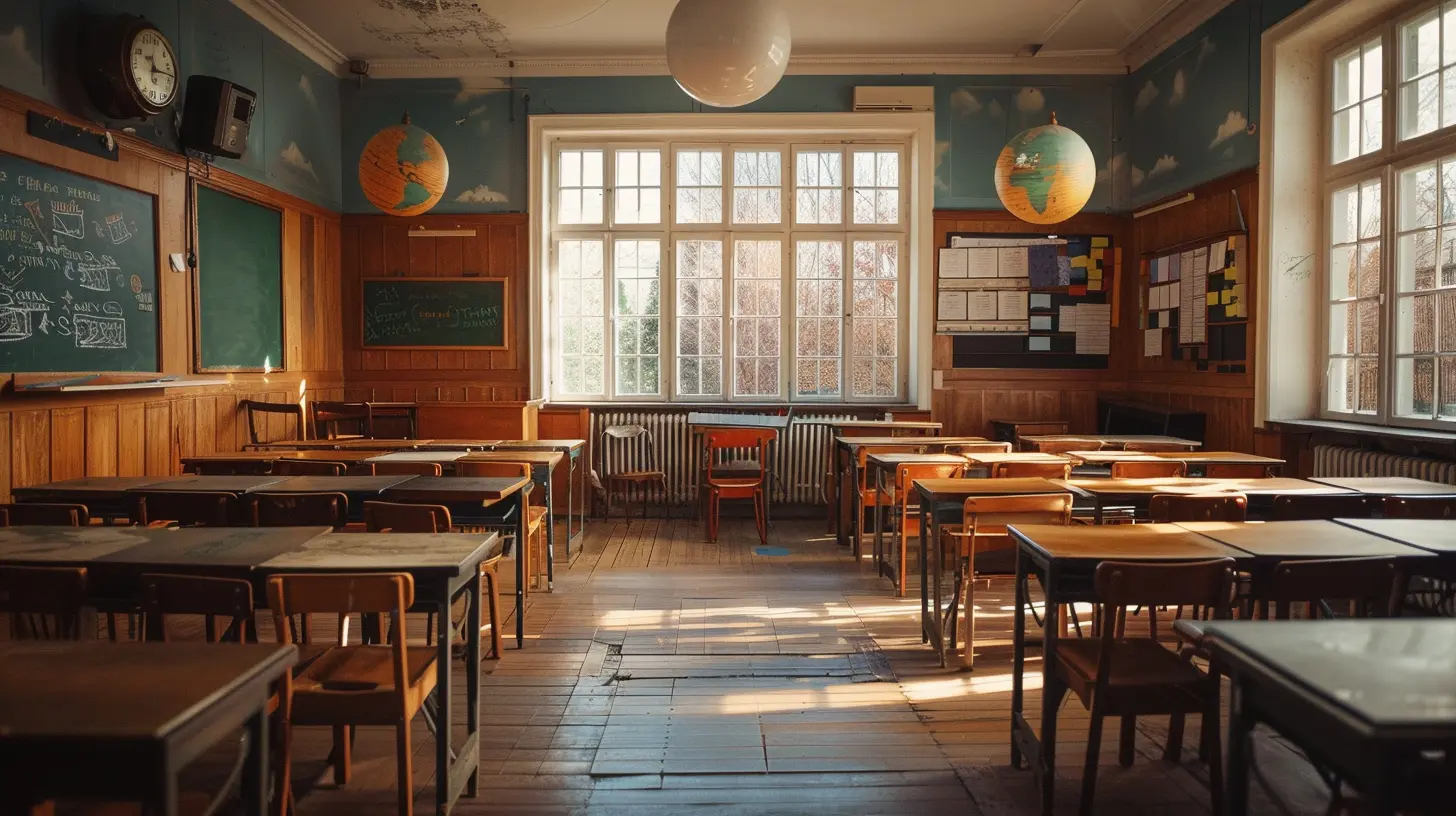How to Promote a Safe and Respectful School Climate
8 April 2025
Creating a safe and respectful school climate isn’t just about enforcing rules—it’s about building a culture where students and staff feel valued, included, and protected. A positive environment boosts academic performance, reduces bullying, and encourages personal growth. But how do we actually make this happen?
Let’s dive into practical strategies that can transform any school into a place where respect and safety are the norm, not the exception.

Why a Safe and Respectful School Climate Matters
A school's climate has a direct impact on student behavior, mental well-being, and academic success. When students feel safe, they’re more likely to engage in learning, participate in activities, and build meaningful relationships. On the flip side, a toxic environment—one filled with bullying, discrimination, or fear—can lead to mental health struggles, absenteeism, and lower academic achievement.Creating a respectful school climate isn’t just about preventing negative behavior; it’s about encouraging positive interactions and fostering a sense of belonging.

1. Establish Clear Expectations and Rules
If students don’t know what’s expected of them, how can they follow the rules? Setting clear, consistent guidelines for behavior helps maintain a structured and respectful environment.How to Do It:
- Develop a school-wide code of conduct that outlines acceptable behavior.- Reinforce rules with posters, handbooks, and regular discussions.
- Make expectations clear from day one—and apply them consistently.
But here’s the catch: Rules alone won’t change behavior. They have to be coupled with positive reinforcement and mutual respect.

2. Encourage Open Communication
Students should feel comfortable speaking up—whether they’re reporting bullying, expressing concerns, or sharing ideas. Open communication fosters trust and strengthens relationships.How to Do It:
- Train teachers to actively listen and respond empathetically.- Set up anonymous reporting systems for students who may be afraid to speak out.
- Host regular forums or town hall meetings where students can voice concerns.
When students know their voices matter, they’re more likely to engage positively with their peers and staff.

3. Promote Social-Emotional Learning (SEL)
Respect and kindness don’t always come naturally—sometimes, they need to be taught. Social-emotional learning (SEL) helps students develop emotional intelligence, conflict-resolution skills, and empathy.How to Do It:
- Incorporate SEL lessons into the curriculum to teach skills like self-awareness, cooperation, and emotional regulation.- Use role-playing exercises to help students handle conflicts constructively.
- Encourage daily reflection activities, such as journaling about gratitude or kindness.
SEL isn’t just about making students nicer—it’s about preparing them for life beyond the classroom.
4. Address Bullying Head-On
Bullying is one of the biggest threats to a safe school climate. It can take many forms—physical, verbal, cyber, or social exclusion. Ignoring it only allows it to thrive.How to Do It:
- Implement strict anti-bullying policies with clear consequences.- Train staff to detect and intervene in bullying situations.
- Encourage bystanders to speak up and support victims.
- Educate students on the impact of bullying through real-life stories and discussions.
No student should ever feel afraid to go to school. Taking a firm stance against bullying is a non-negotiable step in creating a respectful environment.
5. Foster Inclusive and Diverse Communities
A respectful school climate embraces differences, whether they’re cultural, racial, religious, or based on learning abilities. Inclusion helps students feel valued and prevents discrimination.How to Do It:
- Celebrate diverse holidays, traditions, and cultural events.- Create student-led diversity and inclusion groups.
- Ensure the curriculum represents different backgrounds and voices.
- Educate students about bias and stereotypes through workshops and discussions.
Schools should be a reflection of the world—a place where everyone feels seen and accepted.
6. Lead by Example
Students mirror the behavior they see. If teachers, administrators, and staff model respect and kindness, students are more likely to follow suit.How to Do It:
- Treat students with respect and fairness, even when disciplining.- Show empathy in daily interactions—a little kindness goes a long way.
- Address conflicts professionally and avoid favoritism.
Think of it this way: You can’t preach respect while acting disrespectfully. Actions always speak louder than words.
7. Encourage Positive Peer Relationships
Strong friendships and peer connections reduce conflict and promote a sense of belonging. When students feel connected to their peers, they’re less likely to engage in harmful behavior.How to Do It:
- Implement peer mentorship programs where older students guide younger ones.- Encourage collaborative group projects to build teamwork skills.
- Organize team-building activities and bonding exercises.
A united student body leads to a stronger, more respectful school culture.
8. Involve Parents and the Community
A school’s climate isn’t shaped by teachers and students alone—parents, guardians, and the broader community play a huge role. A strong partnership between school and home reinforces values of respect and safety.How to Do It:
- Host parent workshops on topics like bullying prevention and communication skills.- Keep parents informed with regular newsletters and meetings.
- Encourage community involvement through volunteering opportunities and school events.
When schools and families work together, students receive consistent messages about respect and safety at home and in the classroom.
9. Recognize and Reward Positive Behavior
Let’s face it—students respond better to positive reinforcement than punishment. Recognizing good behavior encourages students to continue making respectful choices.How to Do It:
- Create a “Student of the Month” program celebrating kindness and leadership.- Implement small daily or weekly rewards, like praise notes or privileges.
- Use peer recognition programs, where students can nominate each other for acts of kindness.
When students realize that respect and kindness get as much attention as academic achievements, they’ll be more motivated to act accordingly.
10. Support Mental Health and Well-Being
A student struggling with anxiety, depression, or stress won’t thrive in any environment, no matter how respectful it seems. Schools must address mental health proactively.How to Do It:
- Provide easy access to counselors and mental health resources.- Normalize conversations about mental health through awareness campaigns.
- Offer stress-relief activities, like yoga, meditation, or creative arts.
A school that prioritizes mental well-being naturally fosters a more positive and supportive climate.
Final Thoughts
Promoting a safe and respectful school climate isn’t a one-and-done task—it requires ongoing effort, consistency, and a collective commitment from everyone in the school community. But the payoff? A supportive, vibrant environment where students thrive academically, socially, and emotionally.So, whether you’re a teacher, administrator, student, or parent, remember: Respect starts with you. Small actions can lead to big changes. What steps will you take today to create a better school climate?
all images in this post were generated using AI tools
Category:
School SafetyAuthor:

Bethany Hudson
Discussion
rate this article
7 comments
Ivan Graham
This article beautifully emphasizes the importance of fostering a safe and respectful school climate. Together, let’s create supportive environments where every student feels valued and empowered to thrive!
April 21, 2025 at 2:57 AM

Bethany Hudson
Thank you for your kind words! Together, we can make a positive difference in our students' lives.
Vivian Johnson
A safe and respectful school climate isn’t optional; it’s essential. We must demand accountability, foster inclusivity, and challenge disrespect. Every student deserves a thriving environment.
April 16, 2025 at 11:22 AM

Bethany Hudson
Absolutely agree! Creating a safe and respectful school climate is crucial for every student's success. Let's work together to uphold these values!
Inez McNair
Creating a safe and respectful school climate is essential for fostering learning and growth. When we prioritize kindness, inclusivity, and open communication, we empower every student to thrive. Let’s work together to build a supportive environment where everyone feels valued!
April 14, 2025 at 11:40 AM

Bethany Hudson
Thank you for your insightful comment! Promoting kindness and inclusivity is indeed crucial for nurturing a positive school environment. Let’s continue working together to empower all students!
Annabelle McKeehan
Thank you for sharing these valuable insights on fostering a safe and respectful school climate. It’s crucial for educators and students alike to contribute to an environment where everyone feels valued. Your tips inspire proactive changes that can make a significant difference in our schools.
April 13, 2025 at 12:49 PM

Bethany Hudson
Thank you for your kind words! I'm glad you found the insights helpful. Together, we can create positive change in our schools.
Jonah Palmer
In halls where kindness softly blooms, Let respect and safety chase away the glooms. Together we weave a tapestry bright, Where every voice finds strength in light. Nurture harmony, let hearts intertwine, In this sacred space, all souls align.
April 10, 2025 at 6:27 PM

Bethany Hudson
Thank you for beautifully capturing the essence of kindness and respect in our schools! Your words inspire us to create a nurturing environment where every voice is valued and safety thrives.
Rhea McCarron
Creating a safe and respectful school climate empowers students and fosters growth. Together, we can cultivate empathy, understanding, and positive connections for all!
April 8, 2025 at 8:51 PM

Bethany Hudson
Absolutely! A supportive environment is key to student success and growth. Let’s work together to build empathy and connections!
Betsy McGovern
Creating a safe and respectful school climate starts with open communication, empathy, and proactive measures. Encourage student participation in decision-making and establish clear policies to foster an inclusive environment where everyone feels valued and heard.
April 8, 2025 at 4:40 AM

Bethany Hudson
Thank you for your insightful comment! Open communication and student involvement are indeed vital for fostering a safe and inclusive school environment.
MORE POSTS

Exploring the Differences Between Public and Private Universities

Unlocking the Secrets of Pi: A Guide for Students

The Science Behind Ice Cream: Exploring Freezing Points and Mixtures

How to Set Clear Boundaries and Stick to Them

Effective Communication Skills for Professional Educators

Teamwork in the Classroom: Strategies for Effective Group Learning